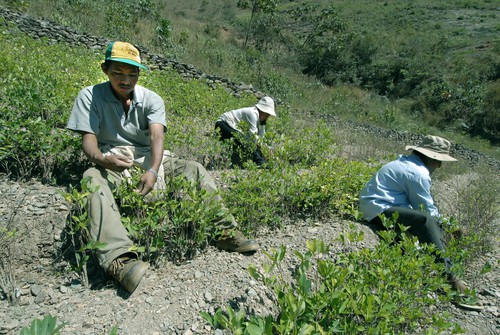Earlier this year, the government of Colombia announced that it would halt aerial spraying of illegal fields of coca crops, the plant used to make cocaine. President Juan Manuel Santos made the decision to halt aerial spraying after the World Health Organization (WHO) reported in March that the glyophosate herbicide “probably” causes cancer in humans. The U.S. Environmental Protection Agency (EPA) claims that there is a lack of clear evidence to link the herbicide to cancer.
There is a long history of drug control policy in Colombia, and the aerial spraying program has been a large part of these policies since the 1980s. The systematic eradication of the illicit coca crops in both Colombia and its neighbor, Bolivia, is a contentious issue and has resulted in numerous human rights violations, according to Connie Veillete, an analyst in Latin American Affairs for the Congressional Research Service (CRS). Veillete also points out that coca cultivation and cocaine production play a larger role in funding the conflict in Colombia between the government, paramilitary groups, and leftist guerilla groups.
Plan Colombia, the U.S.-Colombian aid package to control drug trafficking, was first implemented in 2000. In addition to the military aid provided in the aid package, the U.S. also agreed to this this initiative in order to promote peace and economic development in Colombia and increase stability in the Andean Region. But the primary method for controlling these drug flows has included the forced eradication of the coca plant. Forced eradication, including aerial spraying, has negatively impacted small farmers in the country and has undermined support for the local governments, perpetuating the conflict, according to Veillete.
But the halting of aerial spraying does not mean the end of drug control efforts in Colombia. In addition to the military aid and U.S.-backed aerial spraying, Plan Colombia also includes alternative development programs. These programs, according to the U.N. Office on Drugs and Crime (UNODC), are meant to turn farmers away from growing illicit crops and support their transitions to legitimate industries.
The UNODC’s alternative development programs include initiatives to support families by minimizing their social and economic vulnerabilities, improve infrastructure and access to legitimate markets, and strengthen farming projects.
Alternative development projects have received hundreds of millions of dollars in aid from the U.S. to push guerrilla groups out of rural areas and to support farmers as they shift away from coca into more legitimate industries. In addition to increasing military presence in rural areas, these programs operate mainly by creating agreements with farmers to eradicate their own coca crops with the promise of a provision of resources and economic support.
One of the primary goals of these programs, says the UNODC, is to create farming cooperatives to help farmers overcome a lack of marketing skills, and thus allowing for greater profits. In many of these rural regions of Colombia, communities lack the infrastructure to move goods. Roads are unpaved and flooding near rivers is common. For many, growing coca for drug traffickers is the most lucrative way to earn an income when there is no access to markets to sell legitimate crops.
The U.S. Agency for International Development (USAID) currently operates two alternative development projects in Colombia. The Areas for Municipal-Level Alternative Development (ADAM) and More Investment for Alternative Development (MIDAS) both work to provide technical expertise to farmers and to strengthen local institutions to support changes to legitimate agriculture.
Until now, development projects have been implemented in tandem with the forced eradication initiatives and, according to Viellete, have so far not been highly successful. There has been some criticism about their implementation as a method of drug control rather than as development projects, and these critics have said that by structuring programs as part of a military initiative, they are not equipped to operate in the necessary developmental capacity. Viellete’s report explains that infrastructure projects have been slow to reach rural communities and the Colombian government has shown less interest in programs since Juan Manuel Santos was elected president in 2010.
In a 2010 audit of USAID’s alternative development programs in Colombia, the Regional Inspector General of San Salvador, Catherine Trujillo, wrote that these programs have only partially achieved their main goals. The report states that alternative development “has expanded legitimate livelihoods and promoted sustainable economic development in rural areas vulnerable to illicit crops.” However, the report goes on to state that they have not resulted in a significant reduction of illicit crop production.
The hope, according to Trujillo, is that these programs will promote economic stability and turn poor farmers away from coca cultivation. And Viellete goes on to say that economic growth and sustainable farming and business could also have a positive impact on reducing the violence of the narco-traffickers and guerrilla groups.
Daniel Mejía, the director of the Center for Security and Drug Studies in Bogotá told the New York Times that in order to fight drug trafficking in Colombia, “[he] would recommend attacking the links in the chain of drug trafficking, the labs where cocaine is processed, the large shipments of chemicals, which is really where the hard trafficking is, where organized crime is. It has been shown that attacking the farmers doesn’t work.” The hope of many policy makers is that by ending aerial spraying, future eradication efforts can target the drug traffickers, not the poor rural farmers, and that by promoting sustainable farming and economic growth, development projects will begin to build a more peaceful and prosperous future for the farmers of Colombia.













